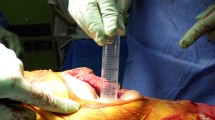Abstract
Purpose
The aim of the study was to quantify the bacterial contamination rate of electrocautery tips during primary total joint replacement (TJR), as well as during aseptic and septic revision TJR.
Methods
A total of 150 electrocautery tips were collected between April and July 2017. TJR surgeries were divided into three groups: (1) primary, (2) aseptic and (3) septic revisions. In each group, a total of 50 electrocautery tips were collected. A monopolar electrocautery with a reusable stainless-steel blade tip was used in all cases. The rate of bacterial contamination was determined for all groups. Correlation of exposure time and type of surgery was analyzed.
Results
The overall bacterial contamination rate was 14.7% (95% CI 9.4 to 21.4%). The highest contamination rate occurred in the septic revision group (30.0%; 95% CI 17.9 to 44.6%), followed by the primary cases group (10.0%; 95% CI 3.3 to 21.8%) and the aseptic revision group (4.0%; 95% CI 0.5 to 13.7%). Exposure time did not affect the bacterial contamination rate. In 12 out of 15 (80%) contaminations identified in the septic group, we found the same causative microorganism of the prosthetic joint infection on the electrocautery tip.
Conclusions
The bacterial contamination of the electrocautery tips is relatively high, especially during septic hip revision arthroplasty. Electrocautery tips should be changed after debridement of infected tissue.
Similar content being viewed by others
References
Mangram AJ, Horan TC, Pearson ML, Silver LC, Jarvis WR (1999) Guideline for prevention of surgical site infection, 1999. Hospital Infection Control Practices Advisory Committee. Infect Control Hosp Epidemiol 20(4):250–278; quiz 279-280. https://doi.org/10.1086/501620
Davis N, Curry A, Gambhir AK, Panigrahi H, Walker CR, Wilkins EG, Worsley MA, Kay PR (1999) Intraoperative bacterial contamination in operations for joint replacement. J Bone Joint Surg Br 81(5):886–889
Falconer TM, Baba M, Kruse LM, Dorrestijn O, Donaldson MJ, Smith MM, Figtree MC, Hudson BJ, Cass B, Young AA (2016) Contamination of the surgical field with Propionibacterium acnes in primary shoulder arthroplasty. J Bone Joint Surg Am 98(20):1722–1728. https://doi.org/10.2106/JBJS.15.01133
Ottesen C, Skovby A, Troelsen A, Specht C, Friis-Moller A, Husted H (2014) No need to change the skin knife in modern arthroplasty surgery. Arch Orthop Trauma Surg 134(8):1163–1166. https://doi.org/10.1007/s00402-014-1974-z
Quint U, Benen T (2016) Possible instrument contamination in the operating room during implantation of knee and hip arthroplasty. Z Orthop Unfall 154(2):157–162. https://doi.org/10.1055/s-0035-1568194
Schweitzer D, Klaber I, Fischman D, Wozniak A, Botello E, Amenabar PP (2015) Surgical light handles: a source of contamination in the surgical field. Acta Orthop Traumatol Turc 49(4):421–425. https://doi.org/10.3944/AOTT.2015.14.0401
Parvizi J, Gehrke T, Chen AF (2013) Proceedings of the International Consensus on Periprosthetic Joint Infection. Bone Joint J 95-B(11):1450–1452. https://doi.org/10.1302/0301-620X.95B11.33135
Shahi A, Chen AF, McKenna PB, Roberts AL, Manrique J, Belden KA, Austin MS (2015) Bacterial contamination in tips of electrocautery devices during total hip arthroplasty. J Arthroplast 30(8):1410–1413. https://doi.org/10.1016/j.arth.2015.03.011
Leary JT, Werger MM, Broach WH, Shaw LN, Santoni BG, Bernasek TL, Lyons ST (2017) Complete eradication of biofilm from orthopedic materials. J Arthroplast 32(8):2513–2518. https://doi.org/10.1016/j.arth.2017.03.050
Figa R, Muneton D, Gomez L, Matamala A, Lung M, Cuchi E, Corona PS (2017) Periprosthetic joint infection by Propionibacterium acnes: clinical differences between monomicrobial versus polymicrobial infection. Anaerobe 44:143–149. https://doi.org/10.1016/j.anaerobe.2017.03.008
Nodzo SR, Westrich GH, Henry MW, Miller AO (2016) Clinical analysis of Propionibacterium acnes infection after total knee arthroplasty. J Arthroplast 31(9):1986–1989. https://doi.org/10.1016/j.arth.2016.02.025
Trampuz A, Zimmerli W (2008) Diagnosis and treatment of implant-associated septic arthritis and osteomyelitis. Curr Infect Dis Rep 10(5):394–403
Zimmerli W, Trampuz A, Ochsner PE (2004) Prosthetic-joint infections. N Engl J Med 351(16):1645–1654. https://doi.org/10.1056/NEJMra040181
Mayer RR, Bederman SS, Colin VM, Berger MM, Cesario TC, Schwarzkopf R (2016) Risk of contamination in assembled vs disassembled instruments in hip arthroplasty surgery. J Arthroplast 31(8):1746–1749. https://doi.org/10.1016/j.arth.2016.02.004
prevention Cfdca (2017) Guideline for disinfection and sterilization in healthcare facilities. https://http://www.cdc.gov/infectioncontrol/guidelines/disinfection/sterilization/steam.html
Frowen P, O’Donnell M, Burrow JG (2010) Neale’s disorders of the foot, 8th edn. Churchill Livingstone
Bennett RG, Kraffert CA (1990) Bacterial transference during electrodesiccation and electrocoagulation. Arch Dermatol 126(6):751–755
Shaw DH, Kalkwarf KL, Krejci RF, Edison AR (1988) Self-sterilization of the electrosurgery electrode. Oral Surg Oral Med Oral Pathol 66(3):290–292
Acknowledgements
The authors acknowledge the support of Dr. S. Schubert and Dr. A. Büter. The work of the study coordinator, Mrs. Gabriele Paprotzki; of Carola Hogrefe (study nurse); and of Dr. Silke Lange (statistician) is also appreciated.
Author information
Authors and Affiliations
Corresponding author
Ethics declarations
Conflict of interest
The authors declare that they have no conflict of interest.
Ethical approval
This study was performed after obtaining approval from the institutional review board. The PV number is “PV5476.”
Rights and permissions
About this article
Cite this article
Abdelaziz, H., Zahar, A., Lausmann, C. et al. High bacterial contamination rate of electrocautery tips during total hip and knee arthroplasty. International Orthopaedics (SICOT) 42, 755–760 (2018). https://doi.org/10.1007/s00264-018-3822-1
Received:
Accepted:
Published:
Issue Date:
DOI: https://doi.org/10.1007/s00264-018-3822-1




